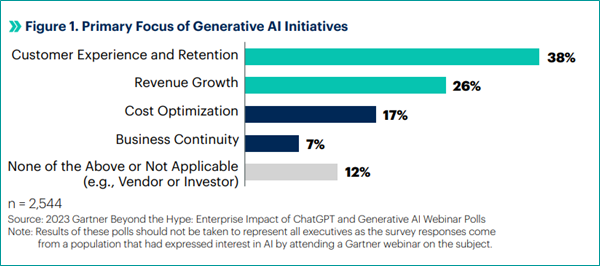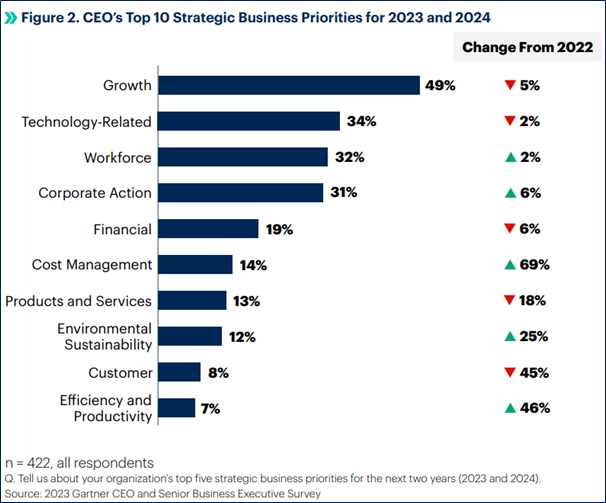GenAI for Customer Experience Expectations

Customers expect effortless access to content, quick resolution of issues, and seamless product experiences – and generative AI is capable enough
Customer retention and growth feature heavily in the plans of executives interested in generative AI. Thirty-eight percent of leaders see improving customer experience and retention as the primary purpose of initiatives to deploy applications trained on large language models, while 26% highlight revenue growth. Only 17% cite cost optimisation, according to the 2023 Q3 report of Gartner Quarterly.

Figure 1: Primary focus of GenAI initiatives; Source: Gartner
Generative AI could help enterprises achieve all three goals by addressing rapidly changing consumer expectations. CEOs report price sensitivity as the top shift in customer behaviour as inflation begins to bite, and 21% of them regard AI as the leading disruptive technology. Executive leaders should, therefore, pilot promising customer-oriented use cases of tools such as ChatGPT and other AI techniques while guarding against the biggest risk.
For example, snack company Mondelēz International created an AI avatar campaign to coincide with the Diwali festival in India. Wendy’s is using Google Cloud’s generative AI technology to enhance its drive-thru ordering service. And UK-based Octopus Energy says AI is doing the work of 250 people at the company by replying to customer emails.
Make Customer Experience & Retention the Core Aim
Customers expect effortless access to content, quick resolution of issues and seamless product experiences. Churn rates can be high if:
- Information provided by the company is inconsistent or even contradictory.
- Resolving problems takes a lot of customer time.
- The value of the product is not intuitive or doesn’t meet expectations.
Smoother encounters with the organisation are the prize to pursue – not just cost cutting. Replacing service people with bots that annoy or frustrate those seeking help will not boost retention. Generative AI, however, has great potential to improve customer experience – and customer relationships – even though some of the use cases are complex and require significant investments.
The technology can enhance value for customers by:
- Educating them on how to use products and services better.
- Advising them on new uses.
- Validating their purchase decisions.
- Anticipating their needs.
- Helping them achieve a goal.
For example, companies could consider using generative AI to onboard new customers or educate existing ones. Generative AI solutions integrated into self-service channels such as virtual assistants can interact in human-like fashion to provide detailed information on products and how to use them.Identify value enhancement opportunities for customers in real time and automate or assist agents to give contextualised information and advice.
Companies could integrate tools such as ChatGPT or other AI techniques to:
- Better understand customer intent and sentiment (through virtual assistants) and help resolve issues efficiently – or route the customer to the best channel to solve them.
- Summarise customer interactions. Generative AI models can do after-call work such as producing call notes, providing updated summaries during the interaction on both voice and text channels, and placing information into enterprise repositories and search engines for continuous improvement. The technology canincrease accuracy and significantly reduce the time service agents spend compiling call notes, thus improving their experience and productivity.
- Close the loop on customer issues. Service organisations can generate emails and texts to customers instantly and efficiently, and enterprise communication platforms can personalise follow-up messages.
- Assist customer support agents by monitoring live interactions to suggest the next best sentence or action. A study by Stanford University and MIT found that agents who used AI tools that created conversational scripts increased their productivity, measured as issues resolved per hour, by 14% on an average.
Customer-Centric Content
Economic uncertainty means efficiency is imperative, and generative AI’s ability to automate the rapid production of more personalised creative content makes it a “must have” for marketing, sales and digital commerce initiatives. More than half of marketing teams (64%) are already leveraging AI heavily to create, execute and optimise campaigns.
Although generative AI promises increased productivity, simply doing more does not guarantee growth. While the volume of content, ads and notifications that customers receive daily is proliferating, the value they attach to the content is strikingly low. Only 5% of consumers recall experiencing valuable digital interactions with a brand when considering a purchase.

Figure 2: Top 10 strategic business priorities – 2023/24; Source: Gartner
Executive leaders should look for points of overlap where generative AI can enhance both content production and personalisation. This mission should not be lefton autopilot, cautions Gartner. Rather, it should beguided with clear use cases, a renewed emphasis on customer research, and human oversight to avoid biases and inappropriate uses.
If organisation can get this step right, marketing will feel empowered to shift focus from more tactical tasks, such as design production, to customer research, strategy and content curation. More resonant and engaging customer experiences will result. It is prudent to regard generative AI as a complement to human expertise, not a substitute. Further, the speed and range of content produced will enable the organisation to reach customers worldwide more efficiently and allow your brands to manage complex customer journeys more effectively.


